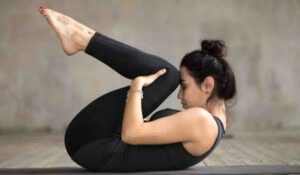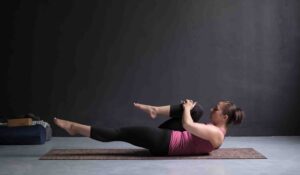Yoga science has been studied extensively since ancient times. Yoga has been proven to improve mental and physical well-being; Regular yoga practice is becoming more popular. These poses can be incorporated into your daily life to provide many benefits for your body and mind.
Let’s look at the benefits of pawanmuktasana, one of many well-known poses.
What is Pawanmuktasana? (Wind Relieving Pose).
As the name implies, Pawanmuktasana is a yoga position that releases gas. This pose is good for releasing gas trapped in the stomach or intestines. This pose helps to stabilize the digestive system and provides relief; The pose works on a holistic level to heal the body, including the mind, neck, stomach, abdomen, hamstrings, and toes.
Pawanmuktasana does not require you to be physically exhausted or tired to practice. The more you hold the pose, the better it is for your body. This is an easy way to expel body wastes and resolve digestive problems. The poses help to stretch the right muscles and loosen the most active ones.
In the next sections, we will discuss the benefits of this pose and how it works. The pose’s focus areas include the lower abdomen, hips, and buttocks. Regular Pawanmuktasana practice is a good way to treat conditions like sterility, impotence, and constipation.
Pawanmuktasana Benefits
Gas release poses are associated with many mental and physical health benefits. Pawanmuktasana is considered one of the best ways to lose belly fat. This pose is beneficial for both mental and physical well-being.
It helps to loosen the spine, reduces gas buildup in the abdomen, and promotes sexual health. This asana can be practiced in the morning to wake up your body and have a positive effect.
Below are some Pawanmuktasana Benefits:
- This pose has been shown to reduce belly fat. Pawanmuktasana is a way to massage the abdominal muscles. This is a great way to lose excess fat.
- You can also stretch your neck and back to relieve tension from the tight areas.
- Complete Pawanmuktasana relieves constipation and other digestive problems.
- The pressure acts on the internal organs, particularly the abdomen, and releases stress hormones. It stimulates the production of digestive enzymes, which helps promote digestion.
- It reduces lower back tension and improves blood circulation to the hip area.
- This is a great way to tone your legs and arms and stimulate the reproductive organs by massaging them. This pose promotes sexual health and strength.
- Pawanmuktasana is a stress-relieving yoga that benefits mental illnesses such as depression, anxiety, and insomnia. It relieves tension and acts on stress areas.
The Science Behind Pawanmuktasana
The human body can accumulate pressure in many forms, including anxiety and stress. Studies show that the Pawanmuktasana, a series of asanas, is beneficial for cardiovascular conditions like high blood pressure.
The pose strengthens the spine, hip, and shoulder muscles during the twisting and rising step. This lengthens the muscles and loosens tight areas; It relieves lower back pain, shoulder pain, and lower back problems.
Regular asana practice can help ease digestion problems and promote a healthy lifestyle. This pose is well-known for its beneficial effects on digestion and stress relief. To relieve tension, the pose stretches the neck and lower abdomen.
How to do Pawanmuktasana
Pawanmuktasana is an asana that helps relieve gastric problems, tension muscles, and mental fatigue. This pose is a good choice for beginners to do yoga. It relieves any gastric problems. As follows:
- Place your back on a yoga mat.
- Take deep, slow breaths while lying down on your back, with your legs together and your hands in front of you.
- This position is ideal for deep meditation.
- Inhale and bring your knees to your chest.
- Let your thighs pressurize your abdomen. Your hands should be tightly clasped.
- During this Pawanmuktasana process, lift your chest and head off the ground to reach a higher position. Your chin should touch your knees.
- Please don’t overdo it or put too much pressure on your muscles during this step.
- While you hold the pose, deepen your breathing and keep your hands on the ground.
- Lower your head and legs to get out of the pose. This completes the Pawanmuktasana.
- After each round, take enough breaks to relax your body.
- Practicing this pose at least 2 to 3 times per week is recommended.
Beginner’s tips
You should remember some things if you’re a novice at Pawanmuktasana.
1) Don’t overstretch your neck and chest muscles. This could result in serious injuries.
2) Keep your lower back grounded when lifting the neck and chest to the highest position.
3) You must lift your buttocks off the ground during the step.
Pawanmuktasana Preparatory Poses
Certain preparatory poses can help you to easily execute any asana. These preparations are a way to ‘warm up for a workout. The Pawanmuktasana exercises improve flexibility; This is a simple pose you can do in any sequence.
You can easily activate the shoulders, neck, and legs with simple techniques for preparatory poses. This stimulates and stretches the muscles enough to perform the pose. These are the steps:
- Relax your body by lying on your back on a yoga mat.
- Begin by raising your legs slowly, one at a. Rotate your ankle.
- Inhale and raise your left leg at 30°. Rotate your ankles.
- Slowly increase the angle from 30 to 60 degrees to get comfortable. Then, increase it to 90 degrees.
- Gradually you’ll feel your calves, legs, and ankles relax. Gradually move from one step to another.
- You can do the same for the second leg. This will allow your body to relax into the pose.
We now move on to the next stage of the preparatory poses.

Supta Matsyendrasana [Supine Spinal Twist Pose]
The Supta Matsyendrasana, or supine twist, is a beneficial pose. It loosens tight shoulders and reduces stiffness in the back.
Twisting your hips aids in digestion. Your digestive organs are irritated by the oxygenated blood. If you have digestive problems, this pose could be beneficial. Follow the instructions below to perform it.
- While lying down on your back, bend your knees at the knees. Slowly bring your knees to your chest. Take deep inhalations as you slowly bring your left-hand side knees to your chest. Next, twist your hips from the hip and shift your left-hand knees towards the floor.
- Your arms should be straight, and your shoulders must be extended sideways towards your body.
- This pose has the advantage of allowing your lower back to open fully. It prepares you for Pawanmuktasana by twisting your hips to move your legs.
- After you’re done with the left-hand side of the project, move on to the right-hand side.
- Keep in mind that the more you twist your hips, the easier it will be to do the pose.
Ardha Pawanmuktasana (Half-Wind Release Pose)
This position puts a lot of pressure on the abdomen. This pose helps to relieve gastric problems and allows for the release of any accumulated gas. This pose can also relieve back pain by loosening stiff or tightened areas in the spine column.
- Inhale while lying on your back. Next, extend your left leg 90 degrees. Bring the knee to your chest. Your hands can hold this leg.
- After taking a few deep breaths, slowly raise your head and bend your right leg 30 degrees. Keep your chin down on your knees.
- This process can be repeated for the second leg.
- You can hold the pose longer as Ardha pawanmuktasana poses do not exert as much pressure as the full Pawanmuktasana position.
Precautions and Contraindications
Yoga poses require complex steps that must be done with care. Neglecting the safety precautions when practicing yoga poses could result in serious injuries. These are some key safety points to remember when practicing Pawanmuktasana:
- Avoid practicing the Pawanmuktasana if you have recently had abdominal surgery or are suffering from a hernia, piles, or any abdominal surgery. This could make the condition worse.
- This asana should not be performed if you have a testicle disorder, hyperacidity, high pressure, neck problems, slipped disks, shoulder problems, or other health issues.
- If you have had a neck injury, your doctor may approve of the asana. Make sure your head is on the ground. You can also support your neck by using a blanket or towel. You will avoid any problems while you perform the pose.
- Do not put too much pressure on your thighs.
- Heart patients could be fatally affected by Pawanmuktasana, so they should avoid it.
Summarising Pawanmuktasana Benefits
Pawanmuktasana is also known for its many benefits as a gas release or wind-relieving pose. Pawanmuktasana can treat everything from digestive problems to sterility or muscle issues; It helps to regulate proper bowel movements.
The Pawanmuktasana procedure begins with the Savasana. It is believed to calm the mind and body. A calm mind can help absorb and distribute energy during exercise; This helps your body to receive various therapies.
Pawanmuktasana permits the free flow of air ( prana) through the entire body. The pose helps the body primarily through three techniques: stretching, pressurizing, and massaging/stimulating. This asana is a major focus on the muscles and inner organs.
It is important to practice asana with the necessary care.
Can we breathe during Pawanmuktasana?
A1. Yes. While practicing Pawanmuktasana, or any other yoga pose, you can and should breathe.
If you have difficulty breathing during Pawanmuktasana, you can observe how and where you should be during the Pawanmuktasana steps. These points will help you understand your breathing patterns.
- Take as many deep as you can during the relaxation phase.
- When you lift your legs, inhale and then exhale.
- As you inhale, bend your knees and raise your head. Inhale deeply. Relax and pay attention to your breathing.
- Relax your grip around your knees and legs with every inhalation. With every inhalation, tighten it.
- When you inhale, bring your neck down to the round ends. Then exhale completely and lie in Savasana.
- Relax for a moment before you begin the second round.
Is Pawanmuktasana good for diabetes?
A2. Patients with Type 2 Diabetes will find the Pawanmuktasana especially beneficial. The Pawanmuktasana reduces belly fat and the waist-to-hip ratio. It has a positive effect on insulin and glucose utilization. Asana can be used to treat diabetes.
What Time Should Pawanmuktasana Take?
A3. Each person is different in their ability to hold and perform the pose.
Start with 10 seconds of Pawanmuktasana. As you need, you can increase the duration to up to one minute.


